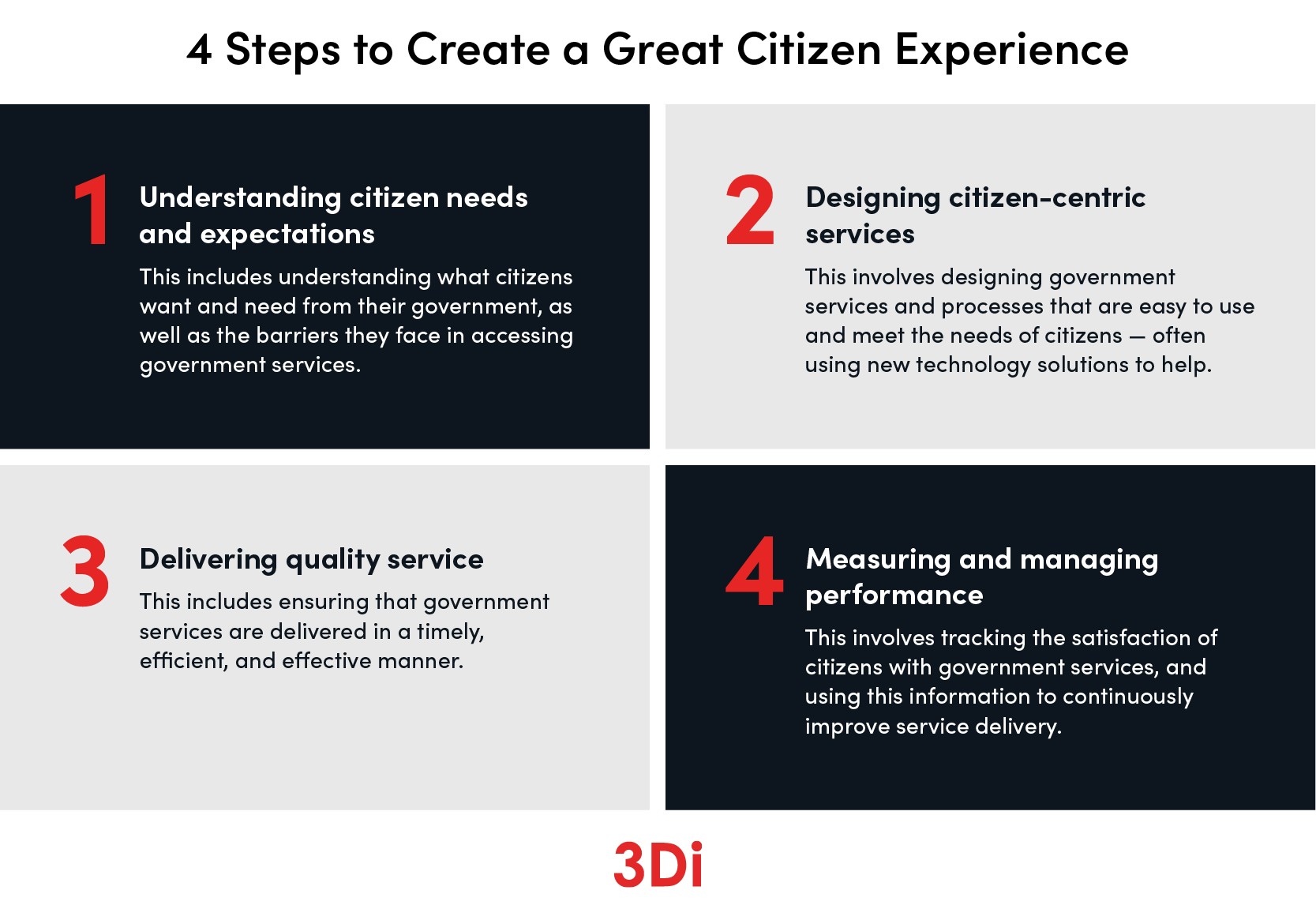A recent executive order from the Biden administration directs agencies to modernize their programs and improve customer experience management, aka citizen experience management. This includes things like reducing the “time tax” citizens face when seeking out services, and adopting new online tools and technologies to improve citizens’ experiences with their governments.
While this order only applies to federal agencies, it illustrates a larger cultural shift towards prioritizing citizen experience, and all levels of government stand to benefit from better citizen experience management.
But what exactly is citizen experience management, and why is it starting to get so much attention?
What is citizen experience management?
Citizen experience management is a type of government-led initiative that uses customer experience or “design-thinking” principles to improve the delivery of public services. It views problems from the lens of the citizen, and develops solutions that consider their needs.
Instead of a bureaucratic system deciding what’s best for its constituents, governments consult citizens and design systems to increase citizen engagement — from agenda setting and policy making to the design and execution of public initiatives.
The goal of citizen experience management is to create more satisfied communities by making it easier for citizens to access government services and information, and by providing a more streamlined and efficient experience.

The topic has been getting more attention lately, in part because people are raising their standards for what they expect from a government interaction. As society becomes more accustomed to the delivery and checkout speeds of private sector businesses (along with more attentive customer service and better integration of programs), they now expect similar improvements in government.
To summarize, you can think about citizen experience management as four key steps:
By taking this citizen-centric approach and understanding the needs and expectations of citizens, governments can design and deliver services that meet or exceed those expectations.
Why is citizen experience management important?
Citizen experience management helps governments identify and address the needs and concerns of their constituents. By understanding what people want and need from their government, officials can make changes that improve the quality of life for everyone involved.
A better citizen experience increases efficiency, enhances mission effectiveness on initiatives, and improves public trust and satisfaction with government. Happy citizens are more likely to participate in government activities and support their community, which helps create a better-functioning city overall.
6 ways to improve your citizens’ experience
1. Implement a customer relationship management (CRM) system
A CRM system can help government agencies keep track of interactions with citizens, including contact information, permit requests, fees, complaints, and more.
CRMs help you create a unified and seamless experience for citizens as they interact with your agency at different times, through different communication channels, and for different reasons. You can also store all your data for each person in a single place, making it easy to reference the information you need, when you need it.
Your CRM may also include tools like an appointment management system, so you can have better control over visitor volume, which in turn can help you use resources more efficiently and effectively. Features like these make it easy for citizens to book, reschedule, or cancel appointments, providing them with relevant information and giving them a greater sense of empowerment from day one.
Bear in mind, not all CRMs are created equal. Look for one that’s been specifically designed to work well for government agencies, rather than a general-purpose CRM that was primarily designed for commercial organizations.
2. Use data analytics
Data analytics can help government agencies understand how citizens are using their services, identify areas that need fixing or improving, and make smarter, data-driven decisions. Data analytics can be especially helpful for identifying which services are being used the most and which ones may be causing problems for citizens.
For instance, if a permit process is taking an unnecessarily long time, this detracts from a citizen's experience, as lost time is a significant cost for individuals. A good analytics system helps you identify issues like this, so you can implement changes to make the process more efficient.
3. Introduce self-service options
Self-service options, such as online portals and chatbots, can help reduce the need for citizens to contact government agencies directly. This can free up staff time to focus on more complex inquiries and improve overall efficiency. You can learn more about this in our citizen self-service guide.
Citizens also love self-service capabilities because it allows them to make a wide variety of requests and get information tailored to them. They can submit these requests from anywhere, at any time, through a wide range of devices and communication channels.
You can take this a step further with a Virtual City Hall, which provides a wide range of services that citizens can access, with little to no time required by government staff. This also includes better two-way communication between citizens and government, so it’s easy for you to convey information, and easy for them to voice questions and concerns when needed.
4. Take advantage of automation
Self-service becomes much easier when you use technology to automate your normal processes. Government automation can not only make your job easier, but it can help you have a much greater impact with the same limited resources.
From handling routine tasks like sending out timely messages to citizens, to streamlining application processes, automation not only helps you get more done with less, but it also means faster turnaround times for citizens who don’t want to wait around to have their issue handled.
5. Provide personalized service
Personalized service is one way to improve citizen experience by making sure that each interaction is tailored to the individual’s needs. For example, you can use data collected from previous citizen interactions to provide more relevant information during future interactions, so an individual can spend less time answering the same questions next time they visit.
This extends to your digital experience too. If your data shows you that citizens are frequently trying to figure out how to pay a certain type of fee online, for instance, you can make that payment section more prominent on your website or online portal, thus reducing the time citizens have to spend completing their payment.
You will have a much easier time providing outstanding personalized service when you have the right CRM in place, as we mentioned in point #1.
6. Invest in training or more intuitive solutions
Training employees on how to use new technologies and how to best serve citizens can help improve overall efficiency and citizen satisfaction levels. However, training can be expensive and time consuming, which is a barrier to adopting new technologies.
That’s why intuitive solutions have become so popular. In the same way that governments are now prioritizing the customer experience for their citizens, software solutions for the public sector are becoming more user-friendly too.
To make sure technical skill is never a barrier, solutions like our 3Di Engage software platform are designed to be easy to learn, even for less tech-savvy employees. But that doesn’t mean you’re left alone to figure it out. 3Di also provides ongoing support to make sure your whole team understands how to use the software, so every employee can help improve the citizen experience.




